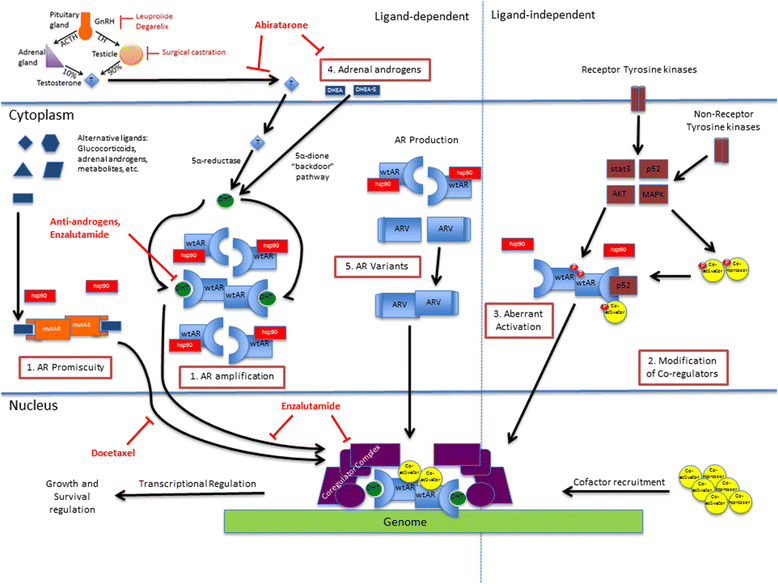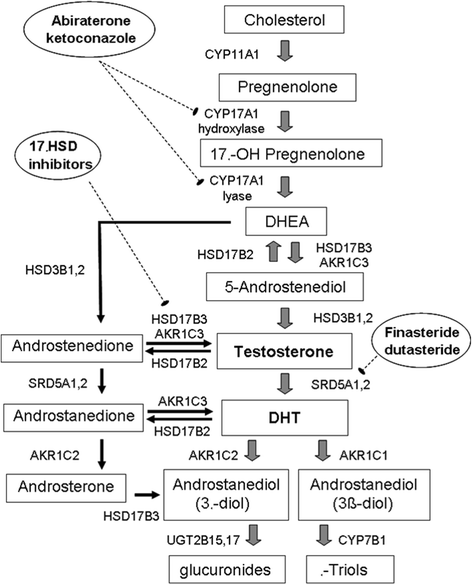Targeting molecular resistance in castration-resistant prostate cancer
- PMID: 26329698
- PMCID: PMC4556222
- DOI: 10.1186/s12916-015-0457-6
Targeting molecular resistance in castration-resistant prostate cancer
Abstract
Multiple mechanisms of resistance contribute to the inevitable progression of hormone-sensitive prostate cancer to castration-resistant prostate cancer (CRPC). Currently approved therapies for CRPC include systemic chemotherapy (docetaxel and cabazitaxel) and agents targeting the resistance pathways leading to CRPC, including enzalutamide and abiraterone. While there is significant survival benefit, primary and secondary resistance to these therapies develops rapidly. Up to one-third of patients have primary resistance to enzalutamide and abiraterone; the remaining patients eventually progress on treatment. Understanding the mechanisms of resistance resulting in progression as well as identifying new targetable pathways remains the focus of current prostate cancer research. We review current knowledge of mechanisms of resistance to the currently approved treatments, development of adjunctive therapies, and identification of new pathways being targeted for therapeutic purposes.
Figures


Similar articles
-
Exploitation of the Androgen Receptor to Overcome Taxane Resistance in Advanced Prostate Cancer.Adv Cancer Res. 2015;127:123-58. doi: 10.1016/bs.acr.2015.03.001. Epub 2015 Mar 29. Adv Cancer Res. 2015. PMID: 26093899 Review.
-
Metastatic castration resistant prostate cancer: current strategies of management in the Middle East.Crit Rev Oncol Hematol. 2014 Apr;90(1):36-48. doi: 10.1016/j.critrevonc.2013.11.001. Epub 2013 Nov 8. Crit Rev Oncol Hematol. 2014. PMID: 24289901 Review.
-
Custirsen (OGX-011) combined with cabazitaxel and prednisone versus cabazitaxel and prednisone alone in patients with metastatic castration-resistant prostate cancer previously treated with docetaxel (AFFINITY): a randomised, open-label, international, phase 3 trial.Lancet Oncol. 2017 Nov;18(11):1532-1542. doi: 10.1016/S1470-2045(17)30605-8. Epub 2017 Oct 9. Lancet Oncol. 2017. PMID: 29033099 Clinical Trial.
-
[Role of chemotherapy in the treatment of castration resistant prostate cancer].Nihon Rinsho. 2016 Jan;74(1):143-8. Nihon Rinsho. 2016. PMID: 26793895 Japanese.
-
Role of the Androgen-Androgen Receptor Axis in the Treatment Resistance of Advanced Prostate Cancer: From Androgen-Dependent to Castration Resistant and Further.J UOEH. 2016 Jun 1;38(2):129-38. doi: 10.7888/juoeh.38.129. J UOEH. 2016. PMID: 27302726 Review.
Cited by
-
Glucocorticoids Induce Stress Oncoproteins Associated with Therapy-Resistance in African American and European American Prostate Cancer Cells.Sci Rep. 2018 Oct 10;8(1):15063. doi: 10.1038/s41598-018-33150-2. Sci Rep. 2018. PMID: 30305646 Free PMC article.
-
Natural Product-Based Studies for the Management of Castration-Resistant Prostate Cancer: Computational to Clinical Studies.Front Pharmacol. 2021 Oct 19;12:732266. doi: 10.3389/fphar.2021.732266. eCollection 2021. Front Pharmacol. 2021. PMID: 34737700 Free PMC article. Review.
-
Androgen downregulation of miR-760 promotes prostate cancer cell growth by regulating IL6.Asian J Androl. 2021 Jan-Feb;23(1):85-90. doi: 10.4103/aja.aja_20_20. Asian J Androl. 2021. PMID: 32415054 Free PMC article.
-
Ginger Phytochemicals Inhibit Cell Growth and Modulate Drug Resistance Factors in Docetaxel Resistant Prostate Cancer Cell.Molecules. 2017 Sep 5;22(9):1477. doi: 10.3390/molecules22091477. Molecules. 2017. PMID: 28872603 Free PMC article.
-
PSMA-targeted radiotheranostics in modern nuclear medicine: then, now, and what of the future?Theranostics. 2024 May 13;14(8):3043-3079. doi: 10.7150/thno.92612. eCollection 2024. Theranostics. 2024. PMID: 38855174 Free PMC article.
References
-
- Studer UE, Hauri D, Hanselmann S, Chollet D, Leisinger HJ, Gasser T, et al. Immediate versus deferred hormonal treatment for patients with prostate cancer who are not suitable for curative local treatment: results of the randomized trial SAKK 08/88. J Clin Oncol. 2004;22:4109–18. doi: 10.1200/JCO.2004.11.514. - DOI - PubMed
Publication types
MeSH terms
Grants and funding
LinkOut - more resources
Full Text Sources
Other Literature Sources

